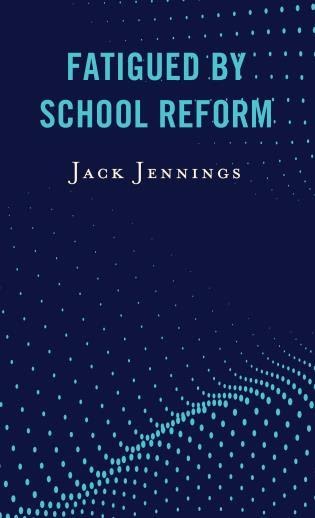
In his new book, “Fatigued by School Reform,” Jack Jennings calls out policy makers, funders and the school reform movement for missing the target on what really influences student success.
I’m very pleased to share my recent interview with Jack about his book, how we got to this moment in history, and his thoughts on what schools and communities face in the disruptions brought by the pandemic we are experiencing.
Jack Jennings is the founder and former CEO of the Center on Education Policy, a Washington D.C.-based nonpartisan, nonprofit education research organization established in 1995. From 1967 to 1994, he served as subcommittee staff director and then as a general counsel for the U.S. House of Representatives’ Committee on Education and Labor.
In addition to this new book, Jack has written 3 other books on school reform and education policy, as well as many articles for publications such as the Washington Post and Huffington Post. You can learn more about Jack Jennings’ new book, “Fatigued by School Reform” at https://rowman.com/ISBN/9781475851281/Fatigued-by-School-Reform.
Q: Your book’s title, “Fatigued by School Reform,” says a lot about the state of education in this country. What motivated you to write the book from this particular perspective, and why at this time?
A: In recent years, I have been stumped by the fact that public schools have had fifty years of reform, and yet the majority opinion is that they are worse today than when most people attended school. Why is that so?
An opportunity to investigate this phenomenon was given to me by an old friend, who is president of a publishing house. He offered to publish a book if I were to write it.
This issue is so important that I don’t regret the year it took me to do this.

Q: The book spotlights two of the most influential factors on student success – the background of students’ parents, and teacher quality. For those readers who may be less familiar with the importance of these two factors, would you share some of the research headlines people need to know and understand?
A: In 1966, James Coleman, a professor at Johns Hopkins University, conducted a study for the federal government which provided the most in-depth view of the public schools that had been done up to that point in time.
The main finding was that the most important factor “by far” indicating a student’s progress in school was the family background of the student. Families with parents having high levels of income, education and job status had children who did well in school. This finding held for these children as a group, not necessarily for each and every student. And, it was downwards from that point. As family income, job status, and education level decreased so did the prospects for the children.
The second element indicating a student’s success was the quality of the teachers. An attribute of a teacher of high quality was high verbal ability. This second factor was important in a student’s success but not nearly as important as family background.
The other factors in education were not as significant as these two. Spending, curriculum, quality of the buildings, and so forth were below them in the list of factors indicating success.

Q: You’ve also observed that years of school reform have focused on many other things – academic standards, testing, school choice, etc. – but less so on those two most influential factors. How, and why, did so many smart people and organizations get it wrong?
A: After its release in 1966, the Coleman report was used by conservatives to oppose higher funding of the schools because increased dollars would not necessarily raise achievement. Liberals used it to promote busing since that would lead to a social mixture with benefits to students from low-income families and no harm to students from higher income households. After the 1970s, other political weapons were found; and the report’s political usefulness declined.
Another factor was that dealing with family backgrounds and the quality of teachers are two difficult issues. Simple solutions were not evident; and so, attention drifted to simpler issues.
During the last five decades, academics from both liberal and conservative camps have challenged Coleman’s findings; but no one has been able to refute them. At conferences he would be acknowledged by name or by finding, but his report lost its wallop as old news.
Q: Philanthropy plays a major role in shaping and advancing national and state education policy, and influencing what happens in schools on the ground. Do you have some examples of where foundations have got it right, and where they’ve missed the mark?
A: As the largest private foundation, the Bill and Melinda Gates Foundation will serve as an example. Gates was successful in funding the development of the Common Core State Standards. That very difficult task resulted in those academic standards being used today in part or in whole in 40 states.
The Gates Foundation’s self-acknowledged failures include spending many millions on promoting the use of students’ test scores in writing teachers’ evaluations and in seeking smaller high schools.
As to the future, since family backgrounds can be improved by the mother or father getting more education or a higher paying job, those activities should be funded by Gates and other foundations. In the book I cite the example when African-Americans in the 1970s attained higher levels of education and employment. Within a few years, the test scores of African-American students increased significantly.
School reform has been over-sold as the remedy for society’s problems. Education in itself cannot solve those problems. The issues of economic and social well-being are for mayors and city councils, governors and state legislators, presidents and Congress to decide. For that reason, school reformers should spend half their time on those issues, which will improve family background and then student academic progress.
Q: Effects of the global pandemic are wreaking havoc on schools, teachers, students, families and communities. What are some of your observations about what K-12 education is facing going forward?
A: In May 2020, dramatic changes are occurring in American education as a result of the campaign to fight the corona virus. Most noteworthy is that no one is physically in school. Everyone is at home–parents, children and teachers, except for parents who are essential employees.
School authorities are using computers to give the semblance that children are being educated. The reality is different.
Some students have completely disengaged, and in effect dropped out. Some students are trying on their own to keep up. Some students have parents who, due to limited education or lack of time away from work, simply cannot help. Some students have parents who can help them. Some are meeting the challenge, and could do so with or without parental assistance.
This range of activities will most likely correlate with the socio-economic status of the students’ parents, with the off-springs of affluent and educated parents doing the best. Others less so.
When the new school year begins in August/September, social distancing may lead to school districts serving half of the current number of students in their current space. Where are the other half of the students going to be educated? Do the rest of the kids stay home, and receive an education using computers? Will students be rotated–one day physically in a school building and one day at home?
Further, unless Washington provides massive aid to states, many teachers may lose their jobs in the coming school year. The economic problems caused by the anti-virus campaign have drastically depressed state revenues.
In May 2020, the Learning Policy Institute released an estimate of job loss they labeled as conservative in an article in Education Week. Three-hundred and twenty thousand teachers could lose their jobs, 8.4% of the teaching force. The impact would vary by state with a high of 20% losing employment.
From this mess of factors, new ways of schooling will emerge because they must. Children have to be educated. As this happens, this question should be asked continuously: how is this change going to deal with parental backgrounds and with improving the quality of teachers? If that question is not often answered positively, the new ways may be no more effective than the old ones were in raising student achievement.
You can contact Jack Jennings through his website, www.jackjenningsdc.com.

